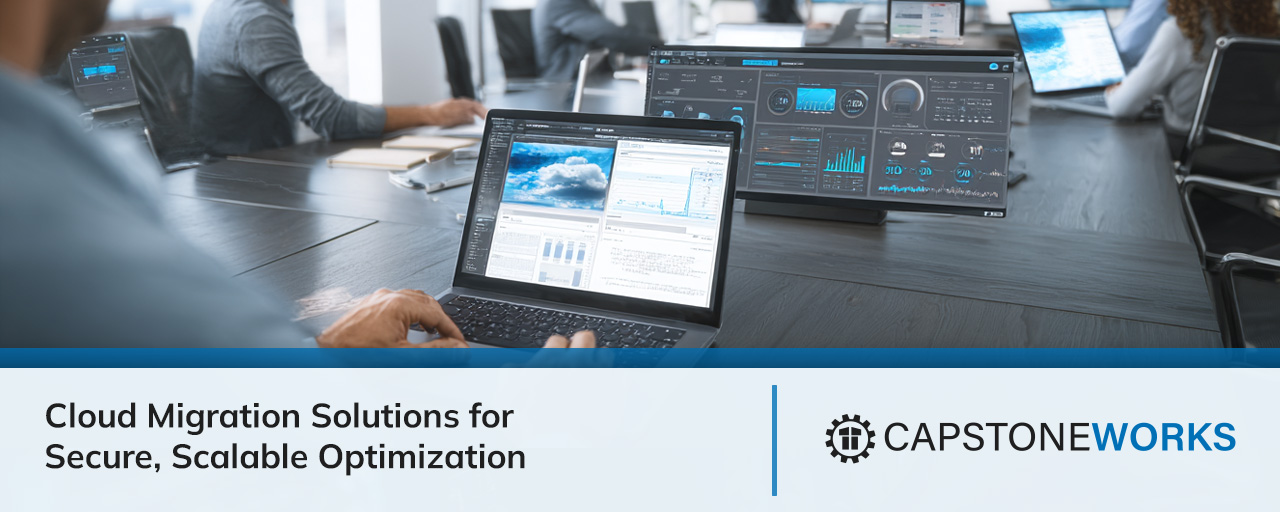Learn how IT network support and IT network services improve uptime, security, and IT network management for growing businesses.
View More


Moving to the cloud is no longer optional for growing businesses—it’s a strategic move to stay competitive. But without the right cloud migration solutions, your business could face downtime, data loss, or security gaps. In this blog, we’ll break down what cloud migration involves, common mistakes to avoid, and how to choose the right tools and service providers. You'll also learn how cloud migration consulting can help you build a solid migration plan and ensure a smooth transition.
Cloud migration solutions help organizations move their IT systems, applications, and data from on-premises infrastructure to a cloud platform. These solutions are essential for businesses looking to modernize their operations, reduce costs, and improve scalability.
A well-executed migration strategy includes planning, selecting the right cloud provider, and using the appropriate migration tools. Whether you're migrating to AWS, Microsoft Azure, or Google Cloud, the goal is to minimize disruption and ensure a secure cloud environment. With the right cloud migration service, you can avoid delays, data loss, and unexpected downtime.

Even with the best intentions, many migrations fail due to poor planning or the wrong tools. Here are the most important steps to get it right:
Before you migrate, be clear about what you want to achieve. Are you trying to reduce costs, improve performance, or increase security? Clear goals help shape your migration plan and guide your decisions.
Not all service providers are the same. Look for one with experience in your industry and a proven track record. A good provider will guide you through the entire migration journey and help avoid costly mistakes.
Understanding your existing IT environment is critical. This includes your applications, data, and network setup. A full assessment helps you identify what needs to be migrated and what can be left behind or modernized.
The right migration tool can make or break your project. Look for tools that support your cloud platform, automate key tasks, and offer strong security features.
Even the best migrations can cause temporary disruption. Plan for it. Schedule your migration during low-traffic periods and communicate clearly with your team.
Once your systems are in the cloud, optimization begins. This includes adjusting performance settings, managing costs, and monitoring usage. Ongoing optimization ensures long-term success.
Security should be built into every stage of your migration. Use encryption, access controls, and regular audits to protect your data in the cloud.
Here’s what you gain by using the right cloud migration solutions:

Once your systems are in the cloud, the work isn’t over. Optimization ensures your cloud environment runs efficiently and cost-effectively. Without it, you may overspend on unused resources or face performance issues.
Cloud migration consulting can help you analyze usage patterns, adjust configurations, and implement automation tools. This ongoing process helps organizations get the most value from their cloud investment.
A seamless migration doesn’t happen by accident. It requires a clear strategy and the right support. Here’s how to build one:
A solid plan outlines what will be moved, when, and how. It should include timelines, roles, and risk mitigation steps.
Not all systems need to move at once. Start with high-impact workloads that benefit most from the cloud. This helps show early wins and reduces risk.
Break your migration into stages. This allows for testing, adjustment, and learning along the way. It also limits disruption to daily operations.
Your staff needs to understand the new cloud environment. Provide training on tools, processes, and security practices to ensure a smooth transition.
Use cloud-native management tools to track performance, usage, and costs. This helps you respond quickly to issues and optimize over time.
Your migration should support broader business objectives. Whether it’s faster innovation or better customer service, keep the focus on outcomes.
Cloud environments change fast. Regular reviews help you adapt your strategy, improve security, and stay aligned with business needs.

Implementing cloud migration solutions starts with choosing the right cloud provider. Consider factors like compliance, pricing, and available services. Then, develop a migration roadmap that includes timelines, testing, and fallback plans.
Work closely with your cloud migration consulting team to ensure each phase is executed correctly. Use automation where possible to reduce manual errors. Finally, validate each stage before moving on to the next.
Follow these best practices to ensure a smooth and secure migration:
A successful migration is not just about moving data—it’s about building a better, more scalable IT foundation.

Are you a business with 25–75 employees looking for reliable cloud migration solutions? If you're growing fast and need to modernize your IT systems without risking downtime or data loss, we can help.
At Capstone Works, Inc., we specialize in guiding companies through every step of the migration journey. From planning and consulting to execution and optimization, our team ensures a smooth, secure cloud migration tailored to your business needs.
A migration service typically handles the technical aspects of moving your systems to the cloud. Cloud migration consulting, on the other hand, focuses on strategy, planning, and long-term optimization. It helps organizations align cloud goals with business needs and avoid common pitfalls.
Both are important. While the service does the heavy lifting, consulting ensures that your migration is efficient, secure, and cost-effective.
Start by assessing your current infrastructure and business goals. Then, compare cloud migration solutions based on features, compatibility, and support. Look for tools that integrate well with your existing systems and offer strong security.
Also, consider working with cloud service providers that offer both migration tools and consulting. This ensures a more seamless experience and better long-term results.
Migrating to the cloud without a plan can lead to data loss, downtime, and security issues. It may also result in higher costs due to poor resource allocation or missed optimization opportunities.
A detailed migration plan helps reduce disruption and ensures that your cloud environment supports your business goals. It also helps you avoid compliance issues and technical errors.
Use monitoring tools to track usage, performance, and costs. Adjust your configurations based on real-time data. This helps avoid over-provisioning and keeps your systems running efficiently.
Cloud migration consulting can also guide you through post-migration optimization. Experts can help you automate tasks, improve security, and align your setup with best practices.
A secure cloud migration includes data encryption, access controls, and regular audits. It also involves choosing a cloud provider with strong compliance standards and security certifications.
During migration, make sure sensitive data is protected at every stage. After migration, continue monitoring for threats and update security policies as needed.
A cloud migration service provider brings experience, tools, and proven processes to your project. They help reduce downtime, avoid mistakes, and ensure a smooth transition.
They also stay updated on the latest cloud technologies and compliance rules. This helps organizations drive innovation while staying secure and efficient.